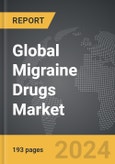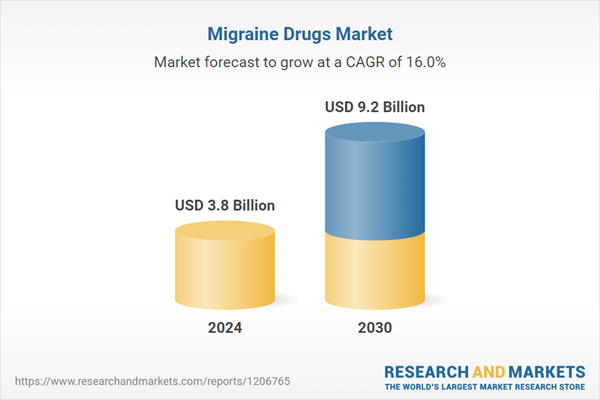The global market for Migraine Drugs was valued at US$3.8 Billion in 2024 and is projected to reach US$9.2 Billion by 2030, growing at a CAGR of 16.0% from 2024 to 2030. This comprehensive report provides an in-depth analysis of market trends, drivers, and forecasts, helping you make informed business decisions. The report includes the most recent global tariff developments and how they impact the Migraine Drugs market.
The global market for migraine drugs has expanded rapidly, driven by the increasing prevalence of migraines and the growing awareness of the condition's impact on quality of life. According to the World Health Organization, migraines are one of the leading causes of disability worldwide, affecting an estimated one billion people. This high prevalence has underscored the need for effective migraine management strategies and spurred research and development in this field. Pharmaceutical companies are investing heavily in the development of novel migraine therapies, including next-generation CGRP inhibitors and combination therapies that offer enhanced efficacy and reduced side effects. Additionally, the introduction of digital therapeutics, which utilize mobile apps and wearable devices to monitor and manage migraines, represents a significant advancement in personalized migraine care. These digital tools enable patients to track their symptoms, triggers, and medication usage, facilitating more precise and effective treatment plans.
The growth in the migraine drugs market is driven by several factors, including technological advancements in drug development, increasing demand for personalized medicine, and the rising prevalence of chronic migraines. Technological innovations have led to the development of more effective and targeted therapies, such as CGRP inhibitors, which have transformed migraine prevention and treatment. The increasing demand for personalized medicine has also propelled the market, as patients seek treatments tailored to their specific genetic and lifestyle factors. Additionally, the rising prevalence of chronic migraines, which affect a significant portion of the global population, has created a substantial demand for effective migraine treatments. The expansion of healthcare infrastructure in emerging markets and the growing accessibility of advanced migraine therapies have further fueled market growth. Furthermore, increased awareness and education about migraines and their treatment options have empowered patients to seek medical help, thereby driving the demand for migraine drugs. These factors collectively contribute to the robust growth of the migraine drugs market, reflecting the ongoing advancements in medical research and the evolving needs of migraine sufferers worldwide.
Segments: Treatment (Acute Treatment, Preventive Treatment); Therapeutic Class (Triptans, Acetylcholine Inhibitors / Neurotoxins, Ergot Alkaloids, NSAIDs, Other Therapeutic Classes); Route of Administration (Oral, Injectables, Other Route of Administrations).
Geographic Regions/Countries: World; United States; Canada; Japan; China; Europe (France; Germany; Italy; United Kingdom; Spain; Russia; and Rest of Europe); Asia-Pacific (Australia; India; South Korea; and Rest of Asia-Pacific); Latin America (Argentina; Brazil; Mexico; and Rest of Latin America); Middle East (Iran; Israel; Saudi Arabia; United Arab Emirates; and Rest of Middle East); and Africa.
The analysts continuously track trade developments worldwide, drawing insights from leading global economists and over 200 industry and policy institutions, including think tanks, trade organizations, and national economic advisory bodies. This intelligence is integrated into forecasting models to provide timely, data-driven analysis of emerging risks and opportunities.
Global Migraine Drugs Market - Key Trends and Drivers Summarized
Migraine drugs are critical in the management and treatment of migraines, a debilitating neurological condition characterized by intense, recurrent headaches often accompanied by nausea, vomiting, and sensitivity to light and sound. These medications are broadly categorized into acute treatments, which alleviate symptoms during a migraine attack, and preventive treatments, which reduce the frequency and severity of attacks. Acute treatments include triptans, ergotamines, and nonsteroidal anti-inflammatory drugs (NSAIDs), while preventive treatments encompass beta-blockers, anticonvulsants, and the newer class of calcitonin gene-related peptide (CGRP) inhibitors. CGRP inhibitors, such as erenumab, fremanezumab, and galcanezumab, have revolutionized migraine prevention by targeting the CGRP pathway, which plays a crucial role in migraine pathophysiology. The availability of these targeted therapies has significantly improved the quality of life for many migraine sufferers who previously found limited relief with traditional medications.The global market for migraine drugs has expanded rapidly, driven by the increasing prevalence of migraines and the growing awareness of the condition's impact on quality of life. According to the World Health Organization, migraines are one of the leading causes of disability worldwide, affecting an estimated one billion people. This high prevalence has underscored the need for effective migraine management strategies and spurred research and development in this field. Pharmaceutical companies are investing heavily in the development of novel migraine therapies, including next-generation CGRP inhibitors and combination therapies that offer enhanced efficacy and reduced side effects. Additionally, the introduction of digital therapeutics, which utilize mobile apps and wearable devices to monitor and manage migraines, represents a significant advancement in personalized migraine care. These digital tools enable patients to track their symptoms, triggers, and medication usage, facilitating more precise and effective treatment plans.
The growth in the migraine drugs market is driven by several factors, including technological advancements in drug development, increasing demand for personalized medicine, and the rising prevalence of chronic migraines. Technological innovations have led to the development of more effective and targeted therapies, such as CGRP inhibitors, which have transformed migraine prevention and treatment. The increasing demand for personalized medicine has also propelled the market, as patients seek treatments tailored to their specific genetic and lifestyle factors. Additionally, the rising prevalence of chronic migraines, which affect a significant portion of the global population, has created a substantial demand for effective migraine treatments. The expansion of healthcare infrastructure in emerging markets and the growing accessibility of advanced migraine therapies have further fueled market growth. Furthermore, increased awareness and education about migraines and their treatment options have empowered patients to seek medical help, thereby driving the demand for migraine drugs. These factors collectively contribute to the robust growth of the migraine drugs market, reflecting the ongoing advancements in medical research and the evolving needs of migraine sufferers worldwide.
Report Scope
The report analyzes the Migraine Drugs market, presented in terms of units. The analysis covers the key segments and geographic regions outlined below.Segments: Treatment (Acute Treatment, Preventive Treatment); Therapeutic Class (Triptans, Acetylcholine Inhibitors / Neurotoxins, Ergot Alkaloids, NSAIDs, Other Therapeutic Classes); Route of Administration (Oral, Injectables, Other Route of Administrations).
Geographic Regions/Countries: World; United States; Canada; Japan; China; Europe (France; Germany; Italy; United Kingdom; Spain; Russia; and Rest of Europe); Asia-Pacific (Australia; India; South Korea; and Rest of Asia-Pacific); Latin America (Argentina; Brazil; Mexico; and Rest of Latin America); Middle East (Iran; Israel; Saudi Arabia; United Arab Emirates; and Rest of Middle East); and Africa.
Key Insights:
- Market Growth: Understand the significant growth trajectory of the Acute Treatment segment, which is expected to reach US$7.2 Billion by 2030 with a CAGR of a 16.6%. The Preventive Treatment segment is also set to grow at 14.1% CAGR over the analysis period.
- Regional Analysis: Gain insights into the U.S. market, valued at $1.0 Billion in 2024, and China, forecasted to grow at an impressive 21.5% CAGR to reach $2.2 Billion by 2030. Discover growth trends in other key regions, including Japan, Canada, Germany, and the Asia-Pacific.
Why You Should Buy This Report:
- Detailed Market Analysis: Access a thorough analysis of the Global Migraine Drugs Market, covering all major geographic regions and market segments.
- Competitive Insights: Get an overview of the competitive landscape, including the market presence of major players across different geographies.
- Future Trends and Drivers: Understand the key trends and drivers shaping the future of the Global Migraine Drugs Market.
- Actionable Insights: Benefit from actionable insights that can help you identify new revenue opportunities and make strategic business decisions.
Key Questions Answered:
- How is the Global Migraine Drugs Market expected to evolve by 2030?
- What are the main drivers and restraints affecting the market?
- Which market segments will grow the most over the forecast period?
- How will market shares for different regions and segments change by 2030?
- Who are the leading players in the market, and what are their prospects?
Report Features:
- Comprehensive Market Data: Independent analysis of annual sales and market forecasts in US$ Million from 2024 to 2030.
- In-Depth Regional Analysis: Detailed insights into key markets, including the U.S., China, Japan, Canada, Europe, Asia-Pacific, Latin America, Middle East, and Africa.
- Company Profiles: Coverage of players such as Allergan PLC, Amgen, Inc., Biohaven Pharmaceutical Holding Company Ltd., Eli Lilly and Company, GlaxoSmithKline PLC and more.
- Complimentary Updates: Receive free report updates for one year to keep you informed of the latest market developments.
Some of the 59 companies featured in this Migraine Drugs market report include:
- Allergan PLC
- Amgen, Inc.
- Biohaven Pharmaceutical Holding Company Ltd.
- Eli Lilly and Company
- GlaxoSmithKline PLC
- Johnson & Johnson
- Pfizer, Inc.
- Teva Pharmaceutical Industries Ltd.
Tariff Impact Analysis: Key Insights for 2025
Global tariff negotiations across 180+ countries are reshaping supply chains, costs, and competitiveness. This report reflects the latest developments as of April 2025 and incorporates forward-looking insights into the market outlook.The analysts continuously track trade developments worldwide, drawing insights from leading global economists and over 200 industry and policy institutions, including think tanks, trade organizations, and national economic advisory bodies. This intelligence is integrated into forecasting models to provide timely, data-driven analysis of emerging risks and opportunities.
What’s Included in This Edition:
- Tariff-adjusted market forecasts by region and segment
- Analysis of cost and supply chain implications by sourcing and trade exposure
- Strategic insights into geographic shifts
Buyers receive a free July 2025 update with:
- Finalized tariff impacts and new trade agreement effects
- Updated projections reflecting global sourcing and cost shifts
- Expanded country-specific coverage across the industry
Table of Contents
I. METHODOLOGYII. EXECUTIVE SUMMARY2. FOCUS ON SELECT PLAYERSIII. MARKET ANALYSISCANADAITALYSPAINRUSSIAREST OF EUROPESOUTH KOREAREST OF ASIA-PACIFICARGENTINABRAZILMEXICOREST OF LATIN AMERICAIRANISRAELSAUDI ARABIAUNITED ARAB EMIRATESREST OF MIDDLE EASTIV. COMPETITION
1. MARKET OVERVIEW
3. MARKET TRENDS & DRIVERS
4. GLOBAL MARKET PERSPECTIVE
UNITED STATES
JAPAN
CHINA
EUROPE
FRANCE
GERMANY
UNITED KINGDOM
ASIA-PACIFIC
AUSTRALIA
INDIA
LATIN AMERICA
MIDDLE EAST
AFRICA
Companies Mentioned (Partial List)
A selection of companies mentioned in this report includes, but is not limited to:
- Allergan PLC
- Amgen, Inc.
- Biohaven Pharmaceutical Holding Company Ltd.
- Eli Lilly and Company
- GlaxoSmithKline PLC
- Johnson & Johnson
- Pfizer, Inc.
- Teva Pharmaceutical Industries Ltd.
Table Information
| Report Attribute | Details |
|---|---|
| No. of Pages | 193 |
| Published | April 2025 |
| Forecast Period | 2024 - 2030 |
| Estimated Market Value ( USD | $ 3.8 Billion |
| Forecasted Market Value ( USD | $ 9.2 Billion |
| Compound Annual Growth Rate | 16.0% |
| Regions Covered | Global |









